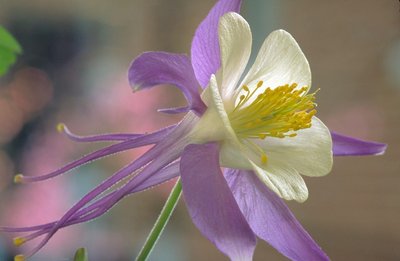Columbine
|
|
Columbine Flower
The columbines are a genus Aquilegia of about 70 species of perennials that are found in meadows, woodlands, and at higher altitudes throughout the northern hemisphere. They are known for their distinctive flowers, generally bell-shaped, with each petal modified into an elongated nectar spur.
Several species are grown in gardens; the European Columbine, Aquilegia vulgaris, is a traditional garden flower in Britain, and several of the species that are native to North America are popular garden plants there. Columbine is a hardy perennial, which propagates by seed. It will grow to a height of 15 to 20 inches. It will grow in full sun; however, it prefers growing in partial shade and well-drained soil and is able to tolerate average soils and dry soil conditions. The leaves of this plant are compound and the flowers contain five sepals, five petals and five pistils. The fruit is a follicle that holds many seeds and is formed at the end of the pistils. Underneath the flower are spurs that contain nectar, mainly consumed by long-beaked birds such as hummingbirds.
They are used as food plants by some Lepidoptera (butterfly and moth) caterpillars. These are mainly of noctuid moths – noted for feeding on many poisonous plants without harm – such as cabbage moth (Mamestra brassicae), dot moth (Melanchra persicariae) and mouse moth (Amphipyra tragopoginis). the engrailed (Ectropis crepuscularia), a geometer moth, also uses columbine as a larval food plant. The larvae of the Papaipema leucostigma also feed on columbine.[7]
Plants in the genus Aquilegia are a major food source for Bombus hortorum, a species of bumblebee. Specifically, they have been found to forage on species of Aquilegia vulgaris in Belgium and Aquilegia chrysantha in North America and Belgium. The bees do not show any preference in the color of the flowers
| Columbine |
|---|


